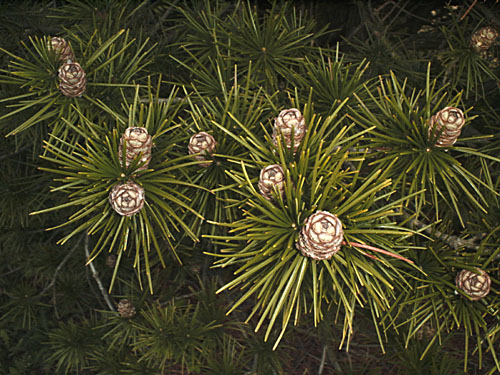David Daehnke
gardeningguru@juno.com
NJ
United States
This page has been visited times.

Sciadopitys verticillata
Japanese Umbrella Pine, Umbrella Pine
Family - Pinaceae
The Japanese umbrella pine is native to Japan and is hardy to zone 5, possibly 4 with protection. This plant really needs winter protection in colder zones, especially from sweeping winter winds that can do major winter damage to it. It is an evergreen conifer, staying a small to medium-sized tree. It is extremely dense and compact when young, which can be a detriment to heavy snowfalls which can break the branches, but also because it has an extremely interesting flaking bark which is reddish-brown in color. Its pyramidal habit make it choice for a medium sized specimen tree that grows to 25 to 40 feet tall and 15 to 20 feet wide.

The whorls of flattened needles around the stems give the look of an umbrella, hence the name. They are dark green and glossy, approximately 2 to 5 inches long. It does produce 2 to 4 inch cones, which are great for the natural decorator in all of us, especially for the holiday wreaths. It grows best in a rich, acidic soil, that is in full sun, but protected from winter winds. As I stated before, it is uncommon and very expensive to purchase, but once you have one on your property, you will admire it for years to come.

Cultivars/Varieties
'Aurea', 'Ossorio Gold' and 'Ann Haddow' - Unusual for their golden yellow needles, these forms are very rare and prized by collectors.
'Jim Cross' - Named in honor of the late Long Island nurseryman, this unusual form grows slowly and densely to 10' tall after many years.
'Joe Kozey' - This Sidney Waxman introduction from the University of Connecticut maintains a columnar habit with healthy green needles.
'Pendula' - This enigmatic form is rarely offered, but is very unusual due to its weeping branches.
'Variegata' - The needles of this hard-to-find variation are colored green and yellow.
'Wintergreen' - Perhaps the finest form, this plant features a narrow conical habit and bright green foliage that does not discolor in winter. The plant grows slowly and often looks so pristine that one could mistake it for plastic. It was developed by Sidney Waxman of the University of Connecticut.
If you have the perfect spot and a few extra dollars to spend, this evergreen will become one of your favorites, guaranteed! Dave aka The Gardening Guru
Remember never to collect plants from the wild. Most reputable garden centers and catalog nurseries will be able to supply you with the plant you are looking for. If you have any questions about certain plants, feel free to e-mail me at plants@gardeningguru.org and I will answer your question as soon as possible!
Hardy Rubber Tree - Eucommia ulmoides
Japanese Tree Lilac - Syringa reticulata